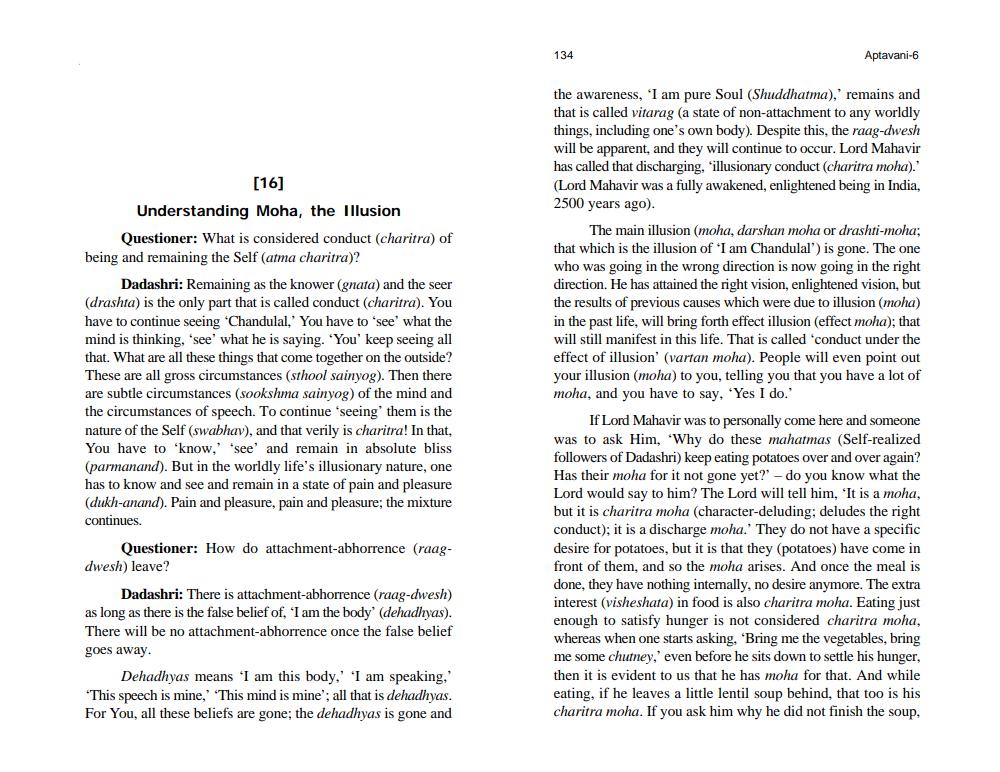________________
134
Aptavani-6
[16] Understanding Moha, the Illusion
Questioner: What is considered conduct (charitra) of being and remaining the Self (atma charitra)?
Dadashri: Remaining as the knower (gnata) and the seer (drashta) is the only part that is called conduct (charitra). You have to continue seeing 'Chandulal,' You have to see what the mind is thinking, 'see' what he is saying. 'You' keep seeing all that. What are all these things that come together on the outside? These are all gross circumstances (sthool sainyog). Then there are subtle circumstances (sookshma sainyog) of the mind and the circumstances of speech. To continue 'seeing them is the nature of the Self (swabhav), and that verily is charitra! In that, You have to 'know,' 'see' and remain in absolute bliss (parmanand). But in the worldly life's illusionary nature, one has to know and see and remain in a state of pain and pleasure (dukh-anand). Pain and pleasure, pain and pleasure; the mixture continues.
the awareness, 'I am pure Soul (Shuddhatma),' remains and that is called vitarag (a state of non-attachment to any worldly things, including one's own body). Despite this, the raag-dwesh will be apparent, and they will continue to occur. Lord Mahavir has called that discharging, 'illusionary conduct (charitra moha).' (Lord Mahavir was a fully awakened, enlightened being in India, 2500 years ago).
The main illusion (moha, darshan moha or drashti-moha; that which is the illusion of 'I am Chandulal') is gone. The one who was going in the wrong direction is now going in the right direction. He has attained the right vision, enlightened vision, but the results of previous causes which were due to illusion (moha) in the past life, will bring forth effect illusion (effect moha); that will still manifest in this life. That is called 'conduct under the effect of illusion' (vartan moha). People will even point out your illusion (moha) to you, telling you that you have a lot of moha, and you have to say, 'Yes I do.'
If Lord Mahavir was to personally come here and someone was to ask Him, 'Why do these mahatmas (Self-realized followers of Dadashri) keep eating potatoes over and over again? Has their moha for it not gone yet?' - do you know what the Lord would say to him? The Lord will tell him, 'It is a moha, but it is charitra moha (character-deluding; deludes the right conduct); it is a discharge moha.' They do not have a specific desire for potatoes, but it is that they (potatoes) have come in front of them, and so the moha arises. And once the meal is done, they have nothing intemally, no desire anymore. The extra interest (visheshata) in food is also charitra moha. Eating just enough to satisfy hunger is not considered charitra moha, whereas when one starts asking, "Bring me the vegetables, bring me some chutney,' even before he sits down to settle his hunger, then it is evident to us that he has moha for that. And while eating, if he leaves a little lentil soup behind, that too is his charitra moha. If you ask him why he did not finish the soup,
Questioner: How do attachment-abhorrence (raagdwesh) leave?
Dadashri: There is attachment-abhorrence (raag-dwesh) as long as there is the false belief of, 'I am the body (dehadhiyas). There will be no attachment-abhorrence once the false belief goes away.
Dehadhyas means 'I am this body,' 'I am speaking," 'This speech is mine,' 'This mind is mine'; all that is dehadhyas. For You, all these beliefs are gone; the dehadhyas is gone and




